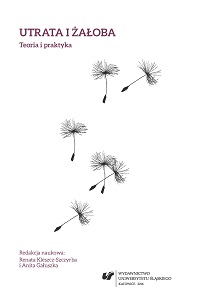Utrata i żałoba. Teoria i praktyka
Loss and grief. Theory and practice
Contributor(s): Anita Gałuszka (Editor), Renata Kleszcz-Szczyrba (Editor)
Subject(s): Social Sciences, Psychology
Published by: Wydawnictwo Uniwersytetu Śląskiego
Keywords: Dying;death;grief;bereavement;
Summary/Abstract: “Dying, death, grief and bereavement are universal problems, engaged by a whole range of scholarly disciplines, including psychology, anthropology, philosophy. These problems are also the focus of culture and art.A strong tendency toward tabooisation of the theme of death, dying and grief obliges the scholarly community to examine this theme closely, against the current trends and fashion. The disassociation from the subjects which generate difficult emotions, which constitute the domain of modern man, prompts scholarship, in a completely paradoxical way, to associate with these problems, to explore and study them. Modern man seems to live as if death was not there, as if it did not apply to him, and which at least constitutes such a remote phenomenon that it does not deserve scrutiny. At the same time, in a completely paradoxical way, it (death) is ever-present in media broadcasts, ensuring greater readership or viewership ratings. It is curious that today there is a need to “debate” about grief (in the social and in the scholarly forum), instead of letting it “fade” (in the mind of the individual).Every instance of loss, if the person who was lost was cherished, requires a period of adaptation. The process of grief determines the rhythm of this adaptation. Every instance of the death of a loved one and each instance of grief after the death of a loved one unfold simultaneously at a number of levels: the intermental level, associated with the experience of grief after loss; the interpersonal level, associated with the dynamics of support and assistance; the cultural level, associated with the understanding of death, the rituals of saying farewell, the places of remembrance, etc. In the monograph, each of these levels will be treated in a more or less comprehensive manner. The first part of the monograph makes reference to the psychology and the philosophy of death, the second part discusses death featured in culture and in art, the third part discusses the problems of a psychological diagnosis and assistance provided in the case of death, and the fourth part focuses on a very peculiar instance of (prenatal and perinatal) loss. As far as the latter is concerned, society is only beginning to learn to come to terms with.The authors of the particular chapters represent various branches of scholarship and practice, owing to which the monograph presents the image of loss and grief in an extremely comprehensive and diversified manner.By presenting this research work to the public, we hope that it will become a source of profound reflection about dying, death and grief. We hope that this reflection will depart from the modern tendencies which promote a “psychological escape” from the subject of death, for death itself always was and always will be a part of life...” (Introduction)
Series: Psychologia
- E-ISBN-13: 978-83-8012-839-2
- Print-ISBN-13: 978-83-8012-838-5
- Page Count: 192
- Publication Year: 2016
- Language: Polish
- eBook-PDF
- Table of Content
- Introduction

